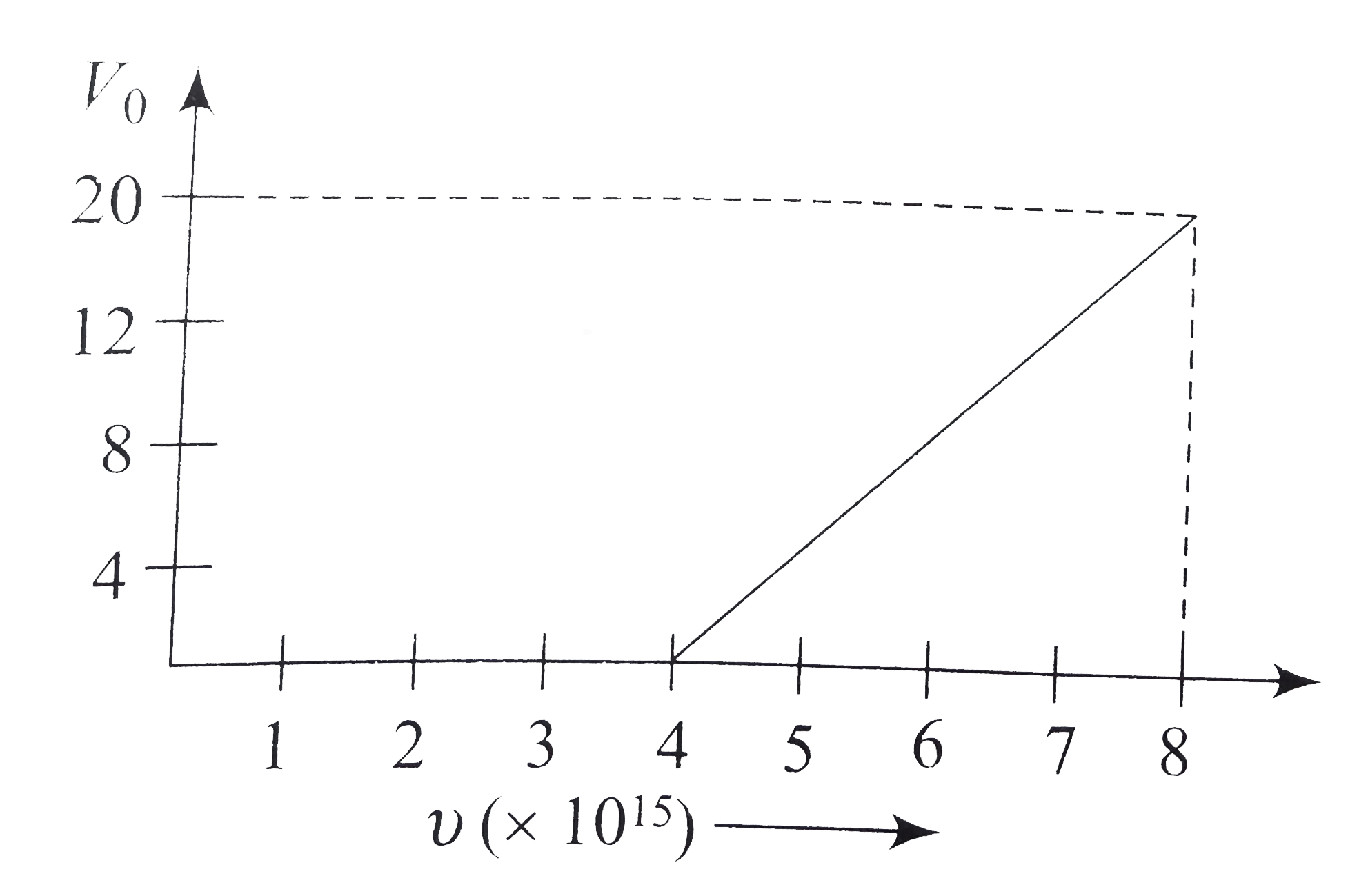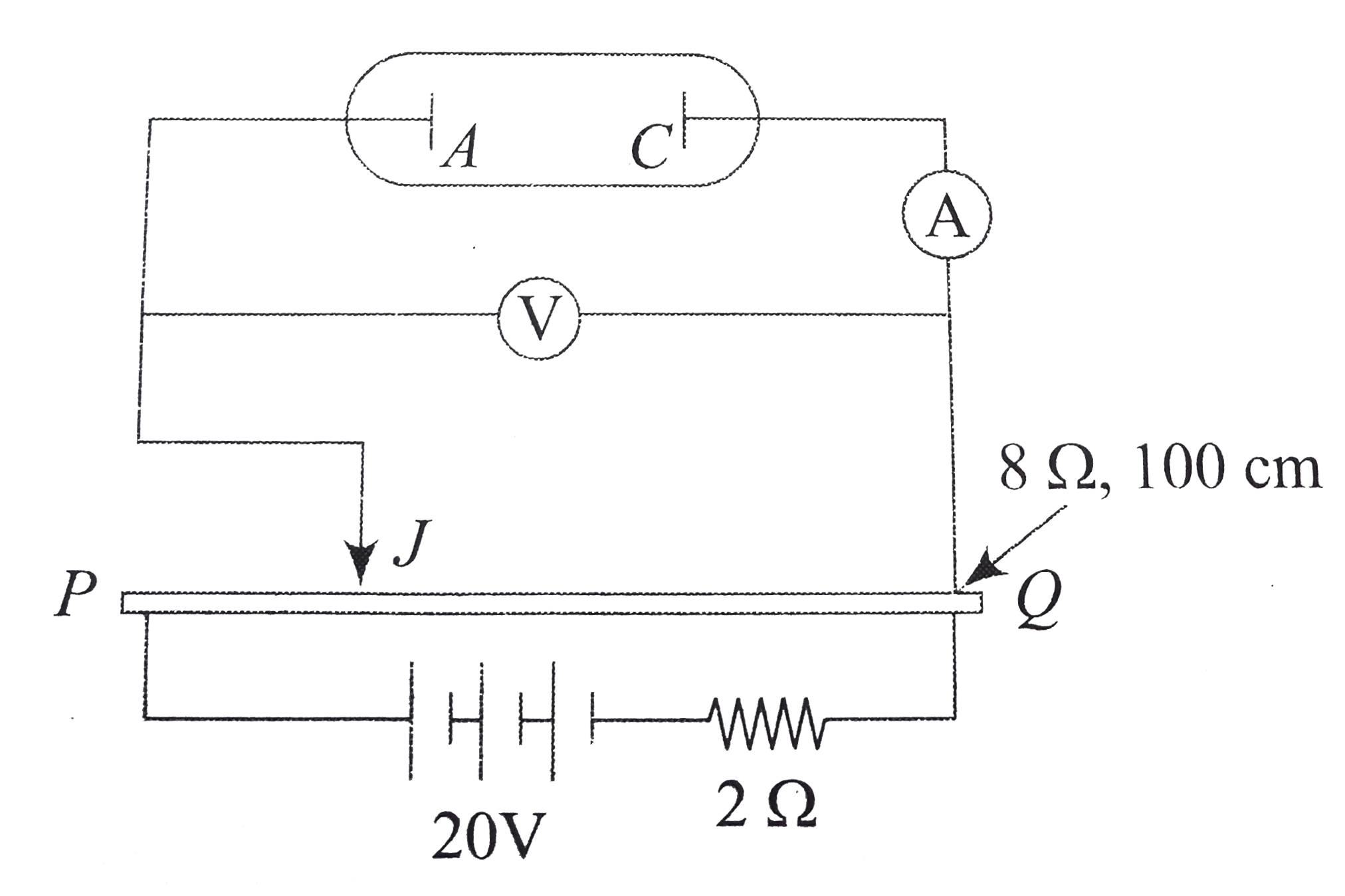A parallel beam of monochromatic radiation of cross-section area A(<πa2), intensity I and frequency v is incident on a solid conducting sphere of work functionϕ0[hv>ϕ0] and radius 'a'. The sphere is grounded by a conducting wire. Assume that for each incident photon one photoelectron is ejected. Just after this radiation is incident on initially unchanged sphere, the current through the conducting wire is:
![A parallel beam of monochromatic radiation of cross-section area A(lt pi a^(2)), intensity I and frequency v is incident on a solid conducting sphere of work functionphi(0)[hv gt phi(0)] and radius 'a'. The sphere is grounded by a conducting wire. Assume that for each incident photon one photoelectron is ejected. Just after this radiation is incident on initially unchanged sphere, the current through the conducting wire is:](https://d10lpgp6xz60nq.cloudfront.net/physics_images/NAR_PHY_XII_V05_C01_E01_235_Q01.png)
IAehv
IAe2hv
2IAehv
23IAehv
The correct Answer is:A
(a) : Energy of each incident photon = hv.
Total energy incident per second on sphere = IA
∴No. of photons incident on sphere per second=IAhv
∴No. of photoelectrons ejected per second=IAhv
Current through the conducting wire = charge flowing per second through wire = IAehv
Topper's Solved these Questions
- DUAL NATURE OF RADIATION AND MATTER BOOK - NCERT FINGERTPS ENGLISHCHAPTER - DUAL NATURE OF RADIATION AND MATTER EXERCISE - EXEMPLAR PROBLEMS
8 Videos
- DUAL NATURE OF RADIATION AND MATTER BOOK - NCERT FINGERTPS ENGLISHCHAPTER - DUAL NATURE OF RADIATION AND MATTER EXERCISE - ASSERTION & REASON CORNER
15 Videos
- DUAL NATURE OF RADIATION AND MATTER BOOK - NCERT FINGERTPS ENGLISHCHAPTER - DUAL NATURE OF RADIATION AND MATTER EXERCISE - DAVISSON AND GERMER EXPERIMENT
3 Videos
- CURRENT ELECTRICITYBOOK - NCERT FINGERTPS ENGLISHCHAPTER - CURRENT ELECTRICITYEXERCISE - Assertion And Reason
15 Videos
- ELECTRIC CHARGES AND FIELDSBOOK - NCERT FINGERTPS ENGLISHCHAPTER - ELECTRIC CHARGES AND FIELDSEXERCISE - Assertion And Reason
15 Videos
Similar Questions
in an experimental set up to study the photoelectric effect a point soure fo light of power 3.2×10−3 W was taken. The source can emit monoenergetic photons of energy 5eV and is located at a distance of 0.8 m from the centre of a stationary metallic sphere of work-function 3.0 eV. The radius of the sphere is r=8..10−3 m. The efficiency of photoelectric emission is one for every 106 incident photons. Based on the information given above answer the questions given below. (Assume that the sphere is isolated and photoelectrons are instantly swepts away after the emission).
de-Broglie wavelength of the fastest moving photoelectron is
View Solutionin an experimental set up to study the photoelectric effect a point soure fo light of power 3.2×10−3 W was taken. The source can emit monoenergetic photons of energy 5eV and is located at a distance of 0.8 m from the centre of a stationary metallic sphere of work-function 3.0 eV. The radius of the sphere is r=8..10−3 m. The efficiency of photoelectric emission is one for every 106 incident photons. Based on the information given above answer the questions given below. (Assume that the sphere is isolated and photoelectrons are instantly swepts away after the emission).
Time after which photoelectric emission stops is
View Solution
Knowledge Check
Two metallic plates AandB , each of area 5×10m are placed parallel to each other at a separation of 1 cm . Plate B carries a positive charge of 33.7 pc . A monochromatic beam of light, with photons of energy 5 eV each, starts falling on plate A at t = 0, so that 10 photons fall on it per square meter per second. Assume that one photoelectron is emitted for every 10 incident photons. Also assume that all the emitted photoelectrons are collected by plate B and the work function of plate A remains constant at the value 2 eV . Electric field between the plates at the end of 10 seconds is
A5×106B7×107C5×107D9×106
in an experimental set up to study the photoelectric effect a point soure fo light of power 3.2×10−3 W was taken. The source can emit monoenergetic photons of energy 5eV and is located at a distance of 0.8 m from the centre of a stationary metallic sphere of work-function 3.0 eV. The radius of the sphere is r=8..10−3 m. The efficiency of photoelectric emission is one for every 106 incident photons. Based on the information given above answer the questions given below. (Assume that the sphere is isolated and photoelectrons are instantly swepts away after the emission).
It was observed that after some time emission of photoelectrons from the sphere stopped. Charge on the sphere when the photon emission stops is
View Solution
When a high frequency electromagnetic radiation is incident on a metallic surface, electrons are emitted from the surface. Energy of emitted photoelectrons depends only on the frequency of incident electromagnetic radiation and the number of emitted electrons depends only on the intensity of incident light.
Einstein's protoelectron equation [Kmax=hv−ϕ] correctly ecplains the PE, where υ= frequency of incident light and ϕ= work function.
Q. For photoelectric effect in a metal, the graph of the stopping potential V0 (in volt) versus frequency υ (in hertz) of the incident radiation is shown in Fig. The work function of the metal (in eV) is.
View SolutionTwo uniform spheres A (Hollow) and B (solid) of same radius R (√125GmPr, where P is _____
View Solution
An experimental setup of verification of photoelectric effect is shown if Fig. The voltage across the electrodes is measured with the help of an ideal voltmeter, and which can be varied by moving jockey J on the potentiometer with wire. The battery used in potentiometer circuit is of 20 V and its internal resistance is 2Ω. The resistance of 100 cm long potentiometer wire is 8Ω.
The photocurrent is measured with the help of an ideal ammeter. Two plates of potassium oxide of area 50cm2 at separation 0.5mm are used in the vacuum tube. Photocurrent in the circuit is very small, so we can treat the potentiometer circuit as an independent circuit. The wavelength of various colors is as follows:
Q. It is found that ammeter current remains unchanged (2μA) even when the jockey is moved from the end P to the middle point of the potentiometer wire. Assuming that all the incident photons eject electrons and the power of the light incident is 4×10−6 W. Then, the color of the incident light is
View Solutionde Broglie proposed dual nature for electron by putting his famous equation λ=hmv. Later on, Heisenberg proposed uncertainty principle as δpΔx≥h4π. On the contrary,
Particle nature of electron was established on the basis of photoelectric effect. When a photon strikes the metal surface it gives up its energy to the electron. Part of this energy (say W) is used by the electrons to escape from the metal and the remaining energy imparts kinetic energy (1/2mv2) to the ejected photoelectron. The potential applied on the surface to reduce the velocity of photoelectron to zero is known as stopping potential .
When a beam of photons of a particular energy was incident on a surface of a particular pure metal having work function =(40 eV), some emitted photoelectrons had stopping potential equal to 22 V. some had 12V and rest had lower values. Calculate the wavelength of incident photons assuming that at least one photoelectron is ejected with maximum possible kinetic energy :
View SolutionA monochromatic light soure of frequency f illuminates a metallic surface and ejects photoelectrons. The photoelectrons having maximum energy are just able to ionize the hydrogen atoms in ground state. When the whole experiment is repeated with an incident radiation of frequency 56f, the photoelectrons so emitted are able to excite the hydrogen atom beam which then emits a radiation of wavelength 1215Å. (a) What is the frequency of radiation? (b) Find the work- function of the metal.
View SolutionIn the shown expermiental setup to study photoelectric effect, two conducting electrodes are enclosed in an evacuated glass-tube as shown. A parallel beam of monochromatic light, falls on photosensitive electrodes. The emf of battery shwon is high enough such that all photoelectron ejected from left electrode will reach the right electrode. Under initial conditions photoelectrons are emitted. AS changes are made in each situation of column-I, Match the statements in column-I with results in column-II.
_E01_128_Q01.png)
Column IColumn II(A)If frequency of incident light is increased keeping its intensity constant(p)magnitude of stopping potential(B)If frequency of incident light is increased and its intensity is decreased(q)current through circuit may stop(C)If work function of photo sensitive electrode is increased(r)maximum kinetic energy of ejected photoelectrons will increase(D)If intensity of incident light is increased keeping its frequency constant(s)saturation current will increase
View Solution
